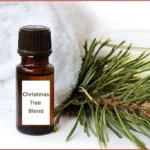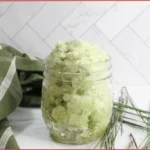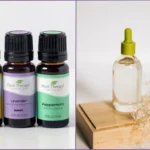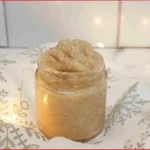There’s something special about the combination of rosemary and lavender. Lavender’s calming floral aroma soothes the senses, while rosemary’s invigorating, herbal scent uplifts and energizes. Together, they support relaxation and rejuvenation in every drop.
This duo’s versatility shines when transformed into an infused oil. Rosemary lavender infused oil benefits range from nourishing your skin to creating moments of calm in the perfect blend of nature and self-care.
Whether you’re using it for a luxurious massage, a soothing bath, or as part of your skincare ritual, this infused oil recipe brings a touch of indulgence to an otherwise ordinary ritual.
Table of Contents
Affiliate Disclosure: Some links on this site are affiliate links. I may earn a small commission if you purchase through them, at no extra cost to you. See the full affiliate disclosure.
What is Rosemary Lavender Infused Oil?

✨ Get 12 Free Holiday Diffuser Blends — Printable PDF
Instantly make your home smell like Christmas with these festive, ready-to-use recipes.
Rosemary lavender-infused oil is a handcrafted blend that combines the natural properties of two aromatic botanicals, rosemary and lavender, into a nourishing carrier oil.
This oil is made by gently soaking dried or fresh herbs in a carrier oil over a period of time, allowing their beneficial compounds to infuse into the oil. The infusion captures the essence of the herbs and flowers steeped in the oil, taking on their aromas, nutrients, and sensory qualities.
In this DIY rosemary lavender infused oil recipe, the two botanicals work beautifully together to create a perfectly balanced infusion that can be used to moisturize your skin, unwind after a long day, or as a comforting aromatherapy massage oil.
Easy to make at home with just three ingredients, this is an ideal DIY project for anyone passionate about natural self-care.
Why Use Rosemary and Lavender Together?

When used together, rosemary and lavender create the perfect balance between invigorating and calming effects. Each plant brings its unique strengths to the table, while complementing each other beautifully.
Rosemary’s Invigorating Touch: Known for its fresh, herbaceous aroma, rosemary is often used in aromatherapy to promote mental clarity and provide a natural sense of alertness. Traditionally, rosemary has been appreciated for its ability to encourage focus and stimulate the senses. It’s energizing in a way that feels natural—no caffeine required.
Lavender’s Soothing Aura: Often called the “herb of relaxation,” lavender excels at creating a calm, peaceful environment. Its floral, slightly sweet scent is instantly comforting and can be part of a relaxing routine. On the skin, lavender is known for its gentle, calming feel, making it a favorite in after-sun oils and DIY body care.
In this DIY rosemary lavender infused oil recipe, the two botanicals balance each other out. While rosemary wakes up your senses, lavender keeps things grounded, creating a fusion that’s both uplifting and relaxing. Think of it as the yin and yang of herbal infusions.
Rosemary lavender infused oil delivers a harmonious experience and works as a versatile, feel-good addition to your self-care toolkit. It’s a fantastic natural choice for DIY skincare, hair care, and aromatherapy rituals.
Rosemary Lavender Infused Oil Benefits for Skin & Hair

When it comes to skin and hair care, rosemary lavender infused oil checks multiple boxes.
Its combination of natural compounds and aromatic qualities can elevate your beauty routine.
Nourishes the Skin: The infusion contains plant-based ingredients that can help lock in moisture and leave your skin feeling soft and hydrated. Lavender’s gentle nature makes it a lovely choice for sensitive skin or post-sun pampering.
Softens and Soothes Skin: If you struggle with dry or rough patches, this infused oil can help improve the feel of your skin, leaving it more supple. It acts like a gentle, nurturing layer for everyday use.
Promotes a Healthy Scalp: Rosemary is often used in hair oils and DIY scalp blends to invigorate the senses during massage. Regular use of this oil on the scalp may help you feel more refreshed and revitalized as part of your hair care routine.
Helps Maintain Scalp Comfort: The fresh, herbaceous qualities of rosemary and lavender can support a clean, balanced scalp environment, making your hair feel light and refreshed.
Incorporate this oil into your hair treatments or your post-shower skincare routine for a sensory boost you’ll enjoy.
Rosemary Lavender Infused Oil Benefits for Relaxation
Rosemary lavender-infused oil offers a natural way to slow down and reconnect after a busy day. The unique blend of aromas creates a perfect balance between calm and clarity.
Soothes the Senses: Lavender’s soft, floral aroma is well-loved for its ability to foster a serene atmosphere. Inhaling the gentle scent as you apply it over your skin can help you settle into a moment of quiet and bring a peaceful energy to your space.
Uplifts & Refreshes: While lavender sets the tone for relaxation, rosemary brings a crisp, herbal brightness to the experience. Together, the scents provide the perfect balance of ease and invigoration, leaving you feeling light and uplifted.
The combination of rosemary and lavender creates what feels like a sensory “reset” for your mood. It’s an excellent choice for moments when you want a calming nudge to help refocus.
Rosemary Lavender Infused Oil Benefits for Wellness
The versatility of rosemary lavender-infused oil extends far beyond beauty and relaxation routines. It’s a wonderful addition to intentional self-care moments.
Promotes a Centered Mindset: The bright and earthy aroma of rosemary, paired with lavender’s gentle floral scent, creates a grounding and refreshing experience. A quick application on your wrists or diffused in a room can help you feel more mindful and present.
Enhances Massage and Rituals: This oil’s smooth, nourishing texture makes it perfect for self-massage or body rituals, combining the joys of hydration with calming aromatherapy.
Supports Self-Care Routines: Use it in a warm bath, as part of a meditation practice, or after a shower for a moment of everyday indulgence. Its versatility makes it a go-to for embracing intentional, restorative living.
Rosemary lavender infused oil is truly a multitasker, making it a favorite among those seeking simple ways to enrich their daily life. Keep it on hand for those moments when you want a soothing, uplifting sensory experience—whether physical or emotional.
How to Make Rosemary Lavender Infused Oil: Ingredients

Making your own rosemary lavender infused oil at home is simpler than you might think. This DIY rosemary lavender infused oil recipe allows you to control the ingredients and quality while also ensuring you’re creating a product tailored to your needs.
Dried Rosemary: Use high-quality dried rosemary leaves to ensure the best infusion. Fresh rosemary can introduce moisture, increasing the risk of spoilage.
Dried Lavender Buds: Make sure the lavender is dried to avoid contamination from water content.
Carrier Oil: The carrier oil you select plays a big role in the final product’s quality. Scroll below for tips on how to choose the best carrier oil for your infusion.
Additional Supplies
Glass Jar: Use a clean, sterilized glass jar with a tight-sealing lid. Mason jars work beautifully for this purpose.
Cheesecloth or Fine Mesh Strainer: These strain out the herbs from the finished oil.
Dark Glass Bottle: After creating the infused oil, store it in a sterilized dark glass bottle to protect it from light and extend its shelf life.
Small Funnel (optional): Helps when transferring oil into smaller bottles without spills.
Labels: If you’re making a batch, label the bottles with the date and contents to stay organized.
Once you have everything ready, it’s time to start infusing!
How to Make Rosemary Lavender Oil Cold Infusion Method

Traditional, 4-6 Weeks – Step-by-Step Instructions
Measure out equal parts dried rosemary and dried lavender buds, or adjust the ratio to your preference. Start with about 1/4 cup of each for every cup of carrier oil.
Make sure the rosemary and lavender are completely dry. Any moisture in the herbs can cause mold during the infusion.
Place the dried rosemary and lavender into your sterilized glass jar.
Pour the carrier oil over the herbs, ensuring they are fully submerged. You may need to gently press the herbs down with a spoon to remove air bubbles. Leave a little space at the top of the jar for easy shaking.
Close the jar tightly and place it in a cool, dark spot for at least four to six weeks. Shake the jar gently every few days.
Once the infusion time is complete 94-6 weeks), strain the oil using a cheesecloth or fine mesh strainer to remove all herbal material.
Squeeze or press the herbs gently to extract as much oil as possible.
Pour the strained oil into a sterilized dark glass bottle, using a funnel for easier transfer. Label the bottle with its contents and the date to keep track of freshness.
Your rosemary lavender infused oil is now ready to use!
How to Make Rosemary Lavender Oil Heat Infusion Method
(Faster, 2-4 Hours)
Heat infusion speeds up the process while still capturing the essence of the herbs. Use this method if you don’t want to wait 4 – 6 weeks.
Prepare the herbs as in the cold infusion method.
Use gentle heat: Place the herbs and oil in a double boiler or a heat-safe jar inside a saucepan of water. Keep the heat on low, ensuring the oil never gets too hot.
Simmer slowly: Allow the mixture to infuse for 2-4 hours, stirring occasionally.
Cool and strain: Once the oil has cooled, strain it as in the cold infusion method.
Store homemade infused oil in a dark glass bottle to protect the oil from harmful UV rays and extend its shelf life. Place the bottle in a cool, dry place, away from sunlight. Light and heat can degrade the oil’s quality over time.
Infused oils with dried herbs typically last 3-6 months. Fresh herb-infused oils are best used within 1-3 months to avoid spoilage. Refrigeration is recommended for fresh herb infusions.
Fresh vs. Dried Herbs: Which is Better for DIY Rosemary-Lavender Infused Oil Recipe?

One of the most common questions I get is whether it’s better to use fresh or dried herbs for this DIY rosemary lavender infused oil recipe. Both options have their own benefits, but dried herbs are generally the better choice for oil infusions.
Why Dried Herbs Are The Better Option
Dried herbs contain little to no moisture, which helps prevent mold and spoilage.
Secondly, since the water content has evaporated, the essential compounds in the herbs become more concentrated, leading to a stronger, longer-lasting infusion.
Dried rosemary and lavender also release their beneficial properties more efficiently into the oil over the longer infusion time.
What Happens When You Use Fresh Herbs
Yes, you can use fresh herbs but they come with some challenges. Because they contain water, they increase the risk of bacterial growth, causing the oil to go rancid or develop mold if not properly dried.
If using fresh herbs, it’s essential to wilt them for a day or two before infusing, allowing some of the moisture to evaporate. However, even with this step, dried herbs are the safer option for long-term storage.
When to Use Dried Vs. Fresh Herbs in Infused Oil Recipes
If you want an infusion with maximum shelf life and potency, go with dried herbs.
If you’re making a small batch for short-term use, fresh herbs can work as long as they are properly wilted and the oil is used within a few weeks.
Best Carrier Oils for DIY Rosemary Lavender Infused Oil Recipe
Carrier oil plays a significant role in determining the texture, absorption rate, and shelf life of your infused oil. Here’s a breakdown to help you make the best choice:
Sweet Almond Oil: Ideal for dry or sensitive skin, this light oil absorbs quickly and provides deep hydration. The mild scent of sweet almond oil works well for rosemary and lavender infusions, allowing their natural aromas to shine through.
Jojoba Oil: Closely mimicking your skin’s natural sebum, jojoba oil is non-comedogenic (won’t clog pores), making it a great choice for those prone to acne or oily skin. It’s also an excellent option for facial and hair massages.
Olive Oil: A heavier oil rich in antioxidants and nutrients, olive oil is perfect for those seeking extra nourishment. It works well for body and hair care but might feel too heavy for facial applications.
Coconut Oil (Fractionated): With a lightweight, non-greasy feel, fractionated coconut oil absorbs into the skin quickly. It also has a long shelf life, making it ideal for extended storage of infused oils. Fractionated coconut oil, which stays liquid, works best for infusions. Regular coconut oil solidifies at cooler temperatures, making it less convenient unless you’re using the oil in warmer conditions.
Grapeseed Oil: Grapeseed is a lighter, fast-absorbing oil suitable for individuals who prefer a non-oily finish. It’s especially great for massages and quick skincare routines.
When choosing a carrier oil for this DIY rosemary lavender infused oil recipe, pick one based on your skin type and intended use. For body care, olive oil or sweet almond oil is ideal for deep hydration.
If you’re focusing on facial application or have oily skin, opt for jojoba or grapeseed oil. Coconut oil offers versatility and longevity, making it great for all-purpose use.
Use only the highest-quality carrier oils in this DIY lavender-rosemary infused oil recipe. Remember, the quality of the carrier oil will directly impact the qualify of the infused oil.
Tips for Optimal Quality and Safety

To ensure the highest quality and safety for your infused oil, keep these tips in mind:
Sterilize Everything: Cleanliness is crucial to prevent bacteria or mold. Wash and sterilize the jar, strainer, and bottles before starting. Dry them thoroughly to avoid introducing water into the oil.
Use Completely Dried Herbs : Fresh rosemary or lavender may seem tempting, but their water content increases the risk of contamination. Stick to dried herbs for a safer and more shelf-stable infusion.
Store Properly: Keep the finished oil in a cool, dark place to protect it from heat and light. A dark glass bottle is ideal because it shields the oil from harmful UV rays.
Check for Spoilage: Over time, infused oils can expire. If the oil smells off or appears cloudy, it’s best to discard it. Proper storage can extend its shelf life up to 6-12 months.
By following these steps and tips, you’ll create a high-quality rosemary lavender infused oil that’s as safe as it is beneficial. It’s a fun and easy way to enjoy the natural goodness of herbs while skipping the unnecessary additives in store-bought versions.
How To Use Homemade Rosemary Lavender Infused Oil
Rosemary lavender infused oil is a versatile addition to your self-care and wellness routines.
With its unique blend of soothing lavender and invigorating rosemary, this infusion can transform ordinary moments into opportunities for self-care.
Here are some ways to get the benefits of rosemary lavender infused oil:
Skincare: Massage a small amount onto damp skin after a shower to lock in hydration. The nourishing properties of rosemary and lavender help improve skin texture, leaving it soft and glowing. Use it regularly as part of your skincare routine.
Hair Care: Apply a few drops to your scalp and massage gently to nourish and revitalize the roots. Rosemary is traditionally associated with promoting healthier-looking hair, while lavender adds a calming effect. Use it as part of a scalp massage to promote healthy follicles or mix it into DIY hair masks to improve softness and shine.
Nail and Cuticle Care: Massage a drop of this infused oil into your nails and cuticles daily to keep them hydrated and healthy-looking. The combination of rosemary and lavender helps soften dry cuticles while promoting a well-groomed appearance. Use the infusion in this cuticle oil recipe for added benefits and a calming scent.
Relaxation: Apply the oil to your pulse points, temples, or behind your neck to create a calming aromatherapy experience. Its soothing scent encourages peace of mind and helps unwind after a busy day.
In DIY Skincare Recipes: Replace the usual carrier oil with rosemary lavender infused oil in DIY skincare recipes. Whether you’re whipping up body scrubs, facial serums, or hair masks, this small substitution will not only enhance the fragrance but also boost the skin-loving properties of your formulations.
Massage Oil: Warm a few drops of the infused oil in your hands and use it during a massage to ease tension and enhance relaxation. Its smooth texture makes it perfect for a spa-like experience at home.
Bath Rituals: Add a teaspoon of the oil to warm bathwater. It disperses into the water, creating a moisturizing and calming soak with subtle herbal aromatherapy benefits. Perfect for winding down after a long day.
This infused oil invites you to seamlessly integrate moments of care, relaxation, and indulgence into your schedule. Whether it’s part of your skincare, aromatherapy, or self-care rituals, its versatility makes it a must-have for any routine.
Can I use solid coconut oil as the carrier oil in this rosemary lavender infused oil recipe?
Solid coconut oil does not work as well in this recipe. Fractionated coconut oil, which stays liquid, works best for infusions. Regular coconut oil solidifies at cooler temperatures, making it less convenient unless you’re using the oil in warmer conditions.
What is the shelf life of homemade rosemary lavender infused oil?
If stored properly in a cool, dark place in a sealed bottle, the oil can last 6 to 12 months. Using dried herbs and a stable carrier oil extends shelf life. If the oil develops a rancid smell or changes texture, it’s time to make a fresh batch.
Can I mix this infused oil with essential oils?
Yes, absolutely! In fact I highly recommend using this power-packed infused oil instead of regular carrier oil in these skincare recipes. Remember, to maintain proper dilution ratios when using essential oils for topical applications.
Is this infused oil safe for sensitive skin?
Rosemary and lavender are generally gentle, but it’s always best to do a patch test before using the oil on sensitive areas. If irritation occurs, dilute further with a mild carrier oil.




